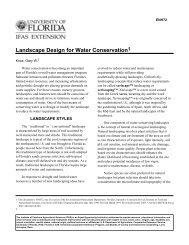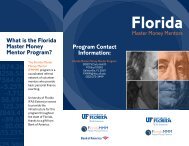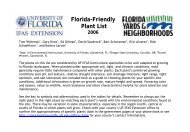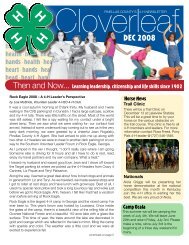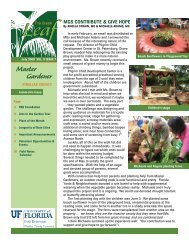Common Coral Species of Southwest Florida - Pinellas County ...
Common Coral Species of Southwest Florida - Pinellas County ...
Common Coral Species of Southwest Florida - Pinellas County ...
You also want an ePaper? Increase the reach of your titles
YUMPU automatically turns print PDFs into web optimized ePapers that Google loves.
<strong>Common</strong> <strong>Coral</strong> <strong>Species</strong> Associated with <strong>Southwest</strong> <strong>Florida</strong><br />
Hardbottom Communities<br />
Although present, the diversity <strong>of</strong> stony and s<strong>of</strong>t corals found <strong>of</strong>f<br />
<strong>Southwest</strong> <strong>Florida</strong>' coast is severely limited compared to what is<br />
found on <strong>Florida</strong>'s east coast. Seasonal temperature fluctuations and<br />
high turbidity rates characteristic <strong>of</strong> Gulf waters provide a less than<br />
hospitable environment for most corals. Yet, several hardy species<br />
do inhabit the region.<br />
A red grouper swimming over a hardbottom community <strong>of</strong>f<br />
the coast <strong>of</strong> Naples, <strong>Florida</strong><br />
Much <strong>of</strong> the shallow continental shelf <strong>of</strong>f <strong>Southwest</strong> <strong>Florida</strong><br />
consists <strong>of</strong> unconsolidated sand and shell rubble substrates<br />
overlying a limestone baserock. Isolated tracks <strong>of</strong> natural<br />
hardbottom ledges and rock outcroppings as well as artificial reefs<br />
are interspersed throughout the region providing suitable substrate<br />
for coral colonization.<br />
Unlike many <strong>of</strong> the corals found in the <strong>Florida</strong> Keys, corals that are associated with <strong>Southwest</strong> <strong>Florida</strong>'s<br />
hardbottom communities, do not construct living reefs. They typically form isolated colonies. These corals and<br />
other associated biota including macroalgae, tunicates, sponges, hydroids, and bryozoans contribute to the<br />
productivity <strong>of</strong> <strong>Southwest</strong> <strong>Florida</strong>'s unique hardbottom communities. They help provide structure, protection,<br />
and food sources for a variety <strong>of</strong> fish assemblages and invertebrates including recreational and commercially<br />
important species such as red grouper (Epinephelus morio ), gag grouper (Mycteroperca microlepis ), and<br />
<strong>Florida</strong> stone crab (Menippe mercenaria ).<br />
<strong>Common</strong> Hard and S<strong>of</strong>t <strong>Coral</strong>s<br />
While not an exhaustive list, below are examples <strong>of</strong> common hard and s<strong>of</strong>t corals associated with natural and<br />
artificial hardbottom communities in <strong>Southwest</strong> <strong>Florida</strong>.<br />
Knobby Star <strong>Coral</strong> (Solenastrea hyades) is one <strong>of</strong> the most common<br />
hard corals found on nearshore natural hardbottoms in <strong>Southwest</strong><br />
<strong>Florida</strong>. Their colonies have lobated heads with irregular bulges on the<br />
surface, and range from a few inches up to two feet in length. Colors<br />
range from yellow-brown to cream to tan. The polyps can <strong>of</strong>ten be seen<br />
feeding during the day.<br />
Starlet <strong>Coral</strong> (Siderastrea spp) colonies form irregular rounded domes and<br />
mounds and vary in color from golden-brown and brown to gray. Colonies<br />
can range from a few inches to several feet.<br />
1
Robust Ivory Tree <strong>Coral</strong> (Oculina robusta) colonies are less common than the star<br />
and starlet corals. <strong>Coral</strong> colonies form large busy, tree-like structures with a thick base.<br />
Colonies can reach close to three feet in length and tend to be yellowish brown.<br />
Tube <strong>Coral</strong> (Cladocora arbuscula) colonies form small<br />
densely branching clumps with fine ridges running their length. Colonies are<br />
usually only several inches and range from tan to golden brown to dark brown in<br />
color.<br />
Hidden Cup <strong>Coral</strong> (Phylangia americana) colonies form small encrusting<br />
groups <strong>of</strong> polyps less than an inch wide. They are found on the undersides <strong>of</strong><br />
ledges or encrusted onto the surface <strong>of</strong> outcroppings and typically yellowish to<br />
reddish brown in color.<br />
Colorful Sea Whips (Leptogorgia virgulata) form long straight, stiff, moderatelybranched<br />
stalks. They can range from yellow to orange to lavender or purple. Their<br />
highly visible polyps are translucent white.<br />
Regal Sea fans (Leptogorgia hebes) colonies are characterized<br />
by being flat and thickly branched, and are generally aligned a<br />
single plain. Like the Colorful Sea Whip, they display a variety<br />
<strong>of</strong> colors ranging from red and orange to reddish purple and purple.<br />
References<br />
Dupont, J.M. 2009. Ledges and Artificial Reefs on the Inner Central West <strong>Florida</strong> Shelf<br />
Dissertation, University <strong>of</strong> South <strong>Florida</strong><br />
Humann, P. 1993. Reef <strong>Coral</strong> Identification: <strong>Florida</strong> Caribbean Bahamas, Including Marine Plants.<br />
Jaap WC.1984. The ecology <strong>of</strong> the South <strong>Florida</strong> coral reefs: a community pr<strong>of</strong>ile. Minerals Management Service<br />
MMS 84–0038. 138 pp Ecological Dynamics <strong>of</strong> Livebottom<br />
Bryan Fluech<br />
Collier <strong>County</strong> Sea Grant Extension Agent<br />
(239) 417-6310 ext 204<br />
Fluech@ufl.edu<br />
The Extension Service is an <strong>of</strong>f-campus branch <strong>of</strong> the University <strong>of</strong> <strong>Florida</strong>, Institute <strong>of</strong> Food and Agricultural Sciences and department with the Public Services Division <strong>of</strong> Collier <strong>County</strong> Government. Extension programs are open to all<br />
persons without regard to race, color, creed, sex, age, handicap, or national origin. In compliance with ADA requirements, participants with special needs can be reasonably accommodated by contacting the Extension Service at least 10<br />
working days prior to the meeting. Contact Extension at (239) 353-4244 or by fax at (239) 353-7127.<br />
2




